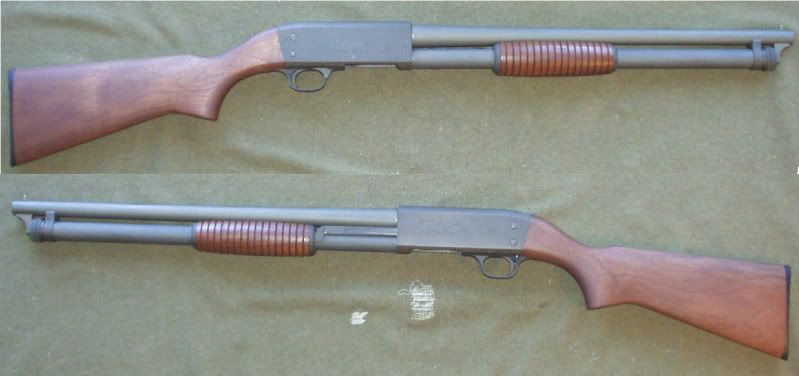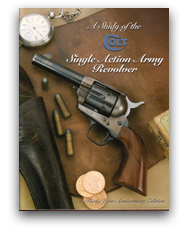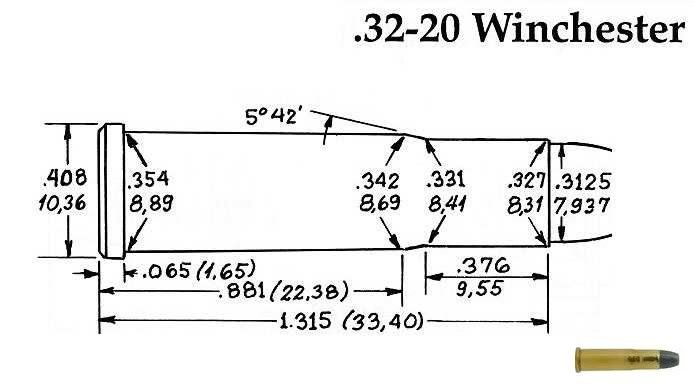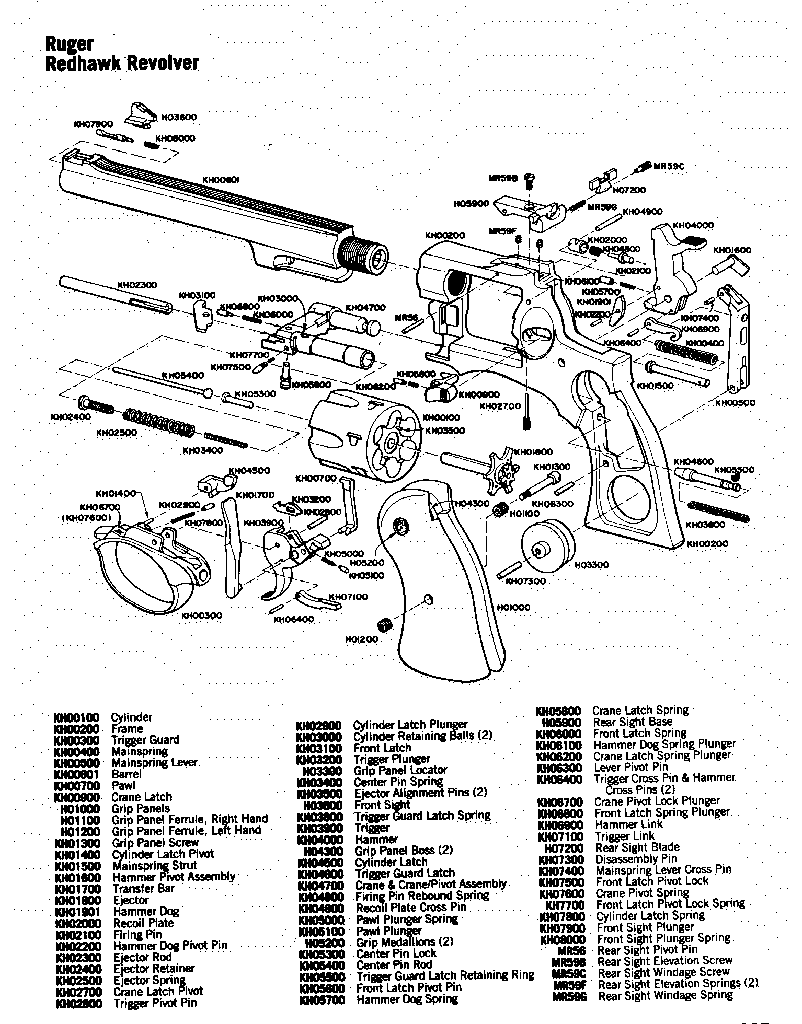 |
| Ithaca Model 37 Riot - right and left side views |
"It" is a 1964 manufactured Ithaca M37 Featherlight, parkerized 12 gauge riot gun with 2-3/4" chamber, 20" barrel and full-length/7-round magazine. UNFIRED, formerly mint and NIB (I've ruined that by simply removing the barrel), this gun has a left-hand safety. That will be changed. It is unfortunate, but I've already discovered that putting my finger on the trigger it automatically pushes the current safety to the ON position, blocking the trigger and making this combat shotgun unshootable. Fortunately, the Ithaca M37 safety is easy to reverse requiring only a bit of screwdriver work (properly fitting screwdrivers, please), time and a right hand safety button. I think this is likely the reason this gun remained in unfired condition.
The Ithaca 37 Featherlight is a legend in the world of pump-action shotguns. The gun was designed by the famous firearms designers John Browning and John Pedersen and first sold as the Remington Model 17. The Model 17 was a 20-gauge of trim proportions which was later redesigned and refined into the popular Remington Model 31 which was replaced by the Remington 870 which is still made.
 After World War One, the Ithaca Gun Company was searching for a pump-action shotgun to produce and compete with the Winchester Model 12. Ithaca waited for Remington Model 17 patents to expire in order to produce that gun. After preparing for production of the Ithaca model 33, they found more Pedersen patents that would not expire until 1937 so, along with the introduction date, they changed the model designation from 33 to 37.
After World War One, the Ithaca Gun Company was searching for a pump-action shotgun to produce and compete with the Winchester Model 12. Ithaca waited for Remington Model 17 patents to expire in order to produce that gun. After preparing for production of the Ithaca model 33, they found more Pedersen patents that would not expire until 1937 so, along with the introduction date, they changed the model designation from 33 to 37.The Great Depression and approaching world war wasn't the best time to introduce a sporting shotgun. That the M37 soldiered through the war proves it is a sound design. Production of many sporting guns ceased during this same period.
Ithaca resumed production of the Model 37 after WW-II. The Ithaca 37 has the longest production run for a pump-action shotgun in history and made in many models. The Ithaca 37 has been called the Model 87, but the M37 name was soon restored. In 2005 production halted when Ithaca once again changed hands but has resumed in Ohio.
This configuration is pretty much limited to use as a self-defense or police firearm. The 7-shot magazine makes it illegal for hunting in most states and most game. Being mostly out of production now, or at least at low production levels compared to some other shotguns, there aren't a lot of accessories out there. I kinda like that. While I have a fully accessorized, modular Winchester 120 (their successor to the M37's competitor the Winchester M12) I like the almost retro simplicity of this shotgun.
Disassembly
Before attempting disassembly, unload the magazine and chamber. To empty the magazine, push in the spring shell stop (13) on the inside of the receiver. Ease the shells out one by one. Pull back on the slide release on the forward side of the trigger guard, and pull back the slide handle to empty the chamber.
To re- move the barrel (1), pull back on the slide release and pull the slide handle assembly (12) to the rear to open the breech. Pull up the magazine nut pin (2) and use it as a lever to rotate the magazine nut (3) until the projection on it is free of the barrel lug. The magazine nut pin was furnished only on guns built prior to 1955. On later-built guns having no pin, simply rotate the magazine nut (Fig. 1).
The barrel is joined to the receiver by an interrupted thread. When the magazine nut is free of the barrel lug, give the barrel a one-quarter turn in the direction shown (Fig. 2) and pull it free of the receiver. The magazine tube and slide handle assembly will remain attached to the receiver.
The stock (53) must be removed before disassembling the action. First remove the buttplate screws and buttplate. The stock is attached to the receiver by a stock bolt (26) that has a square head with a slot so that it can be removed with a long screwdriver or socket wrench (Fig. 3).
With the stock removed, turn out the trigger plate screw (17) (Fig. 4) and slide the trigger plate group to the rear (Fig. 5) and out of the receiver. Remove the carrier screw lock screws (56) and carrier screws (55) from the receiver. Hold the receiver bottom up with the magazine to the left, and with a punch pull the slide pin (33) toward the body (Fig. 6) until the slide bar can be pulled forward from engagement with the slide (35). Pull the slide, breechblock (52) and carrier (42) together rearward out of the receiver.
The top extractor (47) is retained by a powerful spring. To remove it, use a thin punch to push the spring plunger back; at the same time push the extractor out of its seat (Fig. 7). The bottom extractor (43) can be removed easily by driving out its hinge pin (48). To remove the firing pin from the breechblock, first drive out the check pin (49). Then the firing pin and spring (51 and 50) can be removed easily rearward.
Reassembly is in the reverse order.
After about 20 min. including time figuring out WHICH pin punch to use for what AND moving the vise from one bench to the other, I've got a right-hand safety on the Ithaca M-37. Just in time, maybe, well, you know what I mean...
Gunpartscorp.com got the part to me in 4 days start to stop including a Sunday. A record. Correct part and fast...
I had a left-hand Ithaca M-37 safety with large button which I offered for sale here and on a couple of forums. As I believe I noted above, I HAD to switch because putting my finger on the trigger often pushed the safety button to the safe position. Not good in the middle of "use". I had a lot of interest (I was a bit surprised) but folks didn't want to pay as much as Numrich Gun Parts was charging for a used right-hand safety. I sold it for $20 shipped. $25 was too much for anyone but they wouldn't even give a counter-offer. In as much as it seems critical for certainty of use to have the correct safety and the left hand safety seems to be much rarer than the right, AND there are a lot of people out there looking for the left-hand safeties, this might not have been a good move on their part.
Links:
- Ithacagun Featherlight
- Manual - a PDF from Steve's Pages




























